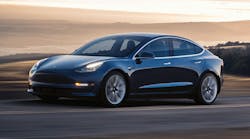Tesla Inc. engineered a late-quarter production burst with the Model 3, the pivotal model in Elon Musk’s quest to put electric cars into the driveways of mainstream consumers. To disprove his doubters, he’ll need to make these manufacturing levels routine.
Output reached 5,031 Model 3s in the last week of the second quarter, exceeding a target that Tesla’s CEO had said was crucial to generating cash and earning profit. About 20% of those cars came off a makeshift line that the company built last month underneath a tent outside its California assembly plant.
Musk sent an email on July 1 to salute staff for achieving a goal to produce 5,000 Model 3s in the final week of June. The progress he celebrated is critical to the carmaker being able to sustain itself financially while pursuing the 47-year-old’s mission to transition the world to battery-powered transportation.
“They’re ramping up production pretty dramatically now,” said Joe Fath, a fund manager for T. Rowe Price, Tesla’s second-largest shareholder, behind only Musk. “They’ve got a lot of vehicles in transit on their way to the sales centers, so that sets them up for a really good third quarter.”
Tesla hasn’t earned an annual profit in its 15-year history. It has regularly had to go back to Wall Street to seek billions of dollars after burning through cash at rates that have alarmed some investors and credit ratings companies.
Fath, who’s based in Baltimore, said Musk hasn’t had trouble raising capital before and won’t if he chooses to do so now.
Sustaining Output
Proving these production rates can be sustained will be key to justifying a market capitalization that’s again surged past General Motors Co. and made Tesla the most valuable U.S. automaker. The skepticism that remains among some investors and analysts contributed to the shares falling as much as 3.2% as of 12:25 p.m. in New York, reversing a gain of as much as 6.4% reached shortly after the start of regular trading.
“We do not see this production rate as operationally or financially sustainable,” said Efraim Levy, an analyst at CFRA Research, who cut his rating on the stock to sell.
Views of a “rosy future” for Tesla may have been priced into the shares before the company reported quarterly results, according to Joe Spak, an analyst with RBC Capital Markets, who rates the shares the equivalent of a hold.
Tesla reaffirmed its guidance for positive net income and cash flow in the third and fourth quarters, even though a weaker dollar and tariffs on vehicles and parts being sent back and forth between the U.S. and China may drag on results. It also forecast that it’ll be able to build 6,000 Model 3s a week by late August.
“The last 12 months were some of the most difficult in Tesla’s history,” the company said on June 30. Achieving the 5,000-a-week Model 3 target “was not easy, but it was definitely worth it.”
Ignored Norms
Tesla eschewed auto industry norms with the Model 3, including by skipping the step of building pre-production prototypes of the car to work out kinks before shipping vehicles to consumers. The company also spent heavily on robots to speed up manufacturing of both sedans and batteries, which Musk has said was a mistake.
“This company ignored what came before them and thought they could do things differently or more efficiently,” Kevin Tynan, a Bloomberg Intelligence analyst, said Monday on Bloomberg Television. Musk found that heavy use of automation “was not the best way to assemble vehicles, and they had to backtrack on some of that.”
Model 3 customers have proven to be a patient bunch through all of Tesla’s manufacturing challenges. The company said the reservation count for the sedan is about 420,000 and that orders may outpace production growth once more cars arrive in stores for test drives.
Tax Credits
While Tesla doesn’t disclose vehicle sales by region, it’s close to reaching 200,000 cumulative sales in the U.S. That’s a critical threshold: Once an automaker reaches that number of electric vehicles, the $7,500 federal tax credit begins to ratchet down and phase out over subsequent quarters.
Tesla delivered 18,440 Model 3s in the second quarter and reported that an additional 11,166 were in transit to customers. The significant number of vehicles in transit may mean the company fell short of the 200,000 mark in June, which would enable the tens of thousands of customers who take delivery this quarter to receive the full tax credit.
By Dana Hull and John Lippert



